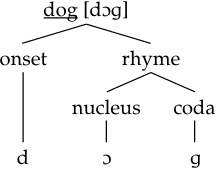


 Grammar
Grammar
 Tenses
Tenses
 Present
Present
 Past
Past
 Future
Future
 Parts Of Speech
Parts Of Speech
 Nouns
Nouns
 Verbs
Verbs
 Adverbs
Adverbs
 Adjectives
Adjectives
 Pronouns
Pronouns
 Pre Position
Pre Position
 Preposition by function
Preposition by function 
 Preposition by construction
Preposition by construction
 Conjunctions
Conjunctions
 Interjections
Interjections
 Grammar Rules
Grammar Rules
 Linguistics
Linguistics
 Semantics
Semantics
 Pragmatics
Pragmatics
 Reading Comprehension
Reading Comprehension|
Read More
Date: 2025-03-12
Date: 2024-02-15
Date: 2024-07-23
|
Syllables and Suprasegmentals
So far, we have considered the phonetic characteristics of individual speech sounds or segments. However, segments do not exist in isolation but are part of larger units, such as syllables, which in turn make up larger units of utterances.
Syllable
The syllable is a phonological unit consisting of segments around the pivotal vowel or vowel-like (diphthong) sound, which is known as the nucleus. The nucleus is the element that every syllable contains, and the other elements are defined in relation to it; the consonant(s) before the nucleus are called the onset, and the consonant(s) after it the coda. Thus, in the following three words we have syllables with different elements: in a [e], we have only the nucleus with no onset and no coda; in at [æt], the syllable consists of the nucleus and the coda and there is no onset; finally, in cat [kæt], we have all three elements present. We will not go into greater detail on various other possibilities.
Nucleus and coda together (the elements after the onset) are known as the rhyme (or rime), thus giving us the following hierarchical structure:

Depending on the structure of the rhyme, syllables are classified as closed (with coda(s)) and open (lacking coda(s)). Thus, in the word beacon [bi.kən] we have an open first syllable followed by a closed second syllable.
|
|
|
|
دخلت غرفة فنسيت ماذا تريد من داخلها.. خبير يفسر الحالة
|
|
|
|
|
|
|
دراسة: الفئران تستخدم "قبلة الحياة" لإنعاش أقرانها
|
|
|
|
|
|
|
أصواتٌ قرآنية واعدة .. أكثر من 80 برعماً يشارك في المحفل القرآني الرمضاني بالصحن الحيدري الشريف
|
|
|